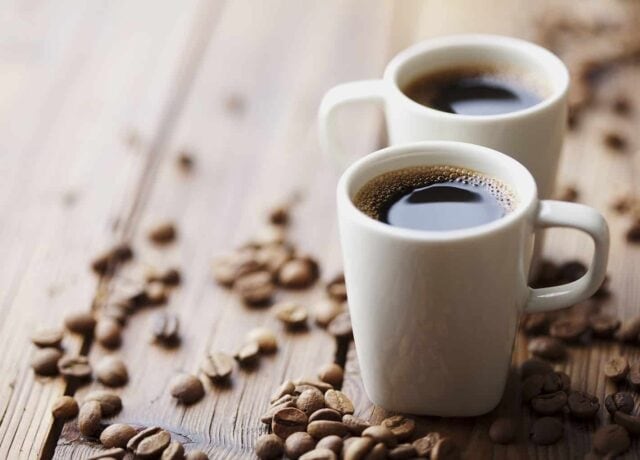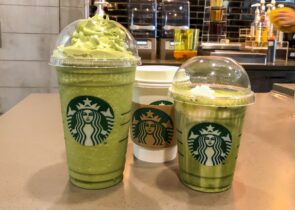![50+ Different Types Of Coffee Drinks Explained [Ultimate Guide] 1 Coffee Types](https://www.roastycoffee.com/wp-content/uploads/Different-Types-of-Coffee-Drinks-2-1.jpg)
Have you thought about expanding your coffee horizons and making a change in your coffee routine, whether it’s something as small as switching beans or brews? That’s great! But do you know how many options are out there? Even we didn’t realize how many coffee types there were.
The fact is, there are many different types of coffee drinks out there just waiting to be enjoyed by you.
Let’s take a look at the coffee types available to you so the next time you’re ready to try something new, all you have to do is consult our handy-dandy list.
Different Types of Coffee Beans
There are many different types of coffee species, not unlike the different species of fruits out there. Still, most of the beans produced and used can be divided into two main species: arabica and robusta. Two less common types are liberica and excelsa, which are rarely seen, especially in the United States.
For those of you who want a little extra info on each of these, read on:
Related: Our Best Coffee Maker Buying Guide
![50+ Different Types Of Coffee Drinks Explained [Ultimate Guide] 2 Coffee Beans](https://www.roastycoffee.com/wp-content/uploads/Types-of-Coffee-Beans-4-1.jpg)
Arabica
Arabica beans are a fan favorite among coffee connoisseurs. They account for a majority of the coffee produced and sold in the world today and about 60 percent of the world’s coffee consumption.
These predominantly Latin America-grown beans are occasionally referred to as mountain varieties because they are grown at higher altitudes with ample shade and steady rainfall. The most serious coffee enthusiasts insist that, of all the beans you can find, these are of the highest quality.
Overall, this is the most “delicate,” or least hardy, of the different coffee bean types. That means that growing arabica beans in the wrong environment could severely and negatively the success of the crop. It also means they’re more susceptible to diseases…plant diseases, not the flu or anything.
Of course, there’s quite a bit of variation among different localities, arabica beans tend to have brighter bodies, and they usually have complex flavor profiles and aromas, which is why they tend to be more popular than other kinds of beans.
Arabica beans are showcased best by hot brewing, especially manual techniques like pour-over. However, their depth and complexity can get overshadowed or diluted if you drown your coffee with milk, creamers, or sugars or use cold brewing methods.
Robusta
Robusta coffee beans, on the other hand, are much stronger and bitter, and rather than gaining popularity through quality and depth of the brew, these plants are popular for their high caffeine levels (boasting around double the caffeine content of arabicas) and hardiness. You’ll find robusta beans in many types of espresso, instant coffee, or regular coffee for those who prefer a really strong cup.
While they do thrive in hotter climates and varied rainfall, robusta beans are known for being able to put up with a much wider range of climates and altitudes as well as withstand disease better than other varieties can. That kind of resistance makes them better for growing large crops.
Higher quality robusta coffee tends to have a lower acidity level and heavy body. These beans stand up better against the additions of cream and sugar, making them great for a drink like Vietnamese Coffee. They also work well in blends that are specifically curated for their caffeine kick, like Death Wish.
Liberica and Excelsa
Two less popular types of coffee beans are liberica and excelsa. The former is grown exclusively in the Philippines and isn’t imported into the U.S. at all, so you probably won’t find any liberica or excelsa drip brew on the local coffee shop menu. The latter, however (which is often considered a genus of liberica beans), is grown in Southeast Asia and makes up about 7 percent of the world’s coffee consumption.
Even though excelsa is a sub-variety of liberica, the two types have very different profiles, so many people still consider them two completely different types of coffee.
Liberica beans peaked in popularity in the 1890s when coffee rust destroyed 90 percent of the world’s arabica crops. Because the Philippines were the first to start any kind of serious production, it became a major supplier. But once the country declared independence, trade between it and the United States was cut off. So by the time a crop of liberica could be re-established, arabica had already reclaimed the top spot for coffee production, and it’s held it ever since.
Liberica beans were (and are when you can find them) known for having a distinct, woody or smoky flavor with a full body and floral or fruity aroma. The tart and fruity excelsa bean, though, is a bit easier to find. It grows on massive 20 to 30-foot coffee trees (as opposed to the maximum six-foot trees that arabica beans grow on). These beans are mostly used to add an extra layer of complexity and depth to coffee blends rather than being sold on their own.
Their light-roast-esque flavors stay true even with slightly dark coffee, which is why some people still seek them out.
Varieties and Varietals Explained
First off, let’s dispel some confusion about the terms variety and varietal. If you’re a long-term coffee lover, you’ve likely stumbled across the words before, but it’s possible you don’t know exactly what they refer to.
A coffee’s variety is a classification term that identifies a specific subspecies or the genetic makeup of the coffee plant. The term varietal is used for the resulting brew or product that comes from a singular variety of coffee. Among coffee varieties, there are original (naturally-occurring) varieties, sub-varieties, mutations, interspecific hybrids, and infraspecific hybrids.
If you’re into botany, going further will likely be pretty interesting, but it may just seem like a bunch of nonsense to the everyday java drinker. Just know you don’t really need to be familiar with every single variety to buy good coffee.
They mainly differ in growth potential and requirements as well as look (bean and leaf shape), which is more important to farmers than it is to you. The quality of the brand you’re buying from should indicate how well they work with the variety they’re growing.
But for those of you who are interested, let’s look at some of the more well-known varieties. Note that each type of bean that follows falls under the arabica family tree.
Typica
Typica is your “typical arabica,” and this variety encompasses a number of the most popular and sought-after regional coffees, including Kona, Java, Jamaican Blue Mountain, and more. This variety originated in Yemen before trade spread it far and wide, first sending it to Malabar, India and Indonesia before eventually reaching the West Indies.
Some subvarieties of these beans include Sumatra, Bergendal, Rume Sudan, Amarello de Botancú, Blawan Paumah, and Java Mocha. There are also many mutations, including Mokka (not to be confused with the mocha drink inspired by these Yemeni beans’ chocolatey flavor), Pluma Hidalgo, Creole, Ethiopian Harrar, Blue Mountain, Villa Sarchi, Ethiopian Sidamo, Ethiopian Yiragacheffe, San Ramón, and Sidikalang, just to name a few.
Bourbon
Bourbon is actually a sub-variety of typica — in fact, it’s probably one of the most common sub-varieties of the bean. It first popped up in the early 1700s when the French brought a typica plant to the island of Bourbon (now Réunion). A slight mutation occurred, and the variety eventually spread across Central and South America.
These plants are popular because they produce more coffee cherries than other typica varieties. Sub-varieties include French Mission, N39, Mayaguez, Arusha, Jackson, K20, Kenya Selected, and SL35. Pointu, Semperlorens, Caturra, SL34, Tekic, and Pacas are mutations of this variety.
Gesha/Geisha
This original variety of arabica coffee is named for the Ethiopian village from which it came and wasn’t planted or harvested commercially until the 1950s. It’s resistant to coffee rust, and it’s now primarily grown in Panama on rather tall trees that sport notably long leaves that mimic the shape of the beans.
More on Varieties
Obviously, these aren’t nearly all of the coffee varieties that are out there, but we figured listing a few might help give you an idea of how they are all interconnected. For further reading, Medium has a helpful “periodic table” you can check out to help demonstrate the connections. And the World Coffee Research catalog is a great resource if you want to explore individual arabica varieties in more detail.
If you’re interested in exploring a wide range of coffees regularly, check out the best coffee of the month clubs.
Now, let’s move on to the simultaneously more and less complex world of coffee drinks, shall we?
Coffee Types: A Full Breakdown
Of course, the biggest differences in coffee occur in the drinks themselves. Not only do different brewing styles give coffee some of its most unique flavors, but something as simple as a thin layer of foam or a dash of milk can take your coffee or espresso-based drink to another level.
Let’s take a look at some of the most popular coffee drinks out there.
Brewing Methods
![50+ Different Types Of Coffee Drinks Explained [Ultimate Guide] 3 Brewing Method](https://www.roastycoffee.com/wp-content/uploads/Brewing-Method-2-1.jpg)
But before you know what kinds of coffee drinks are out there, you’ll need to determine which brewing method (or methods, if you’re a coffee drinker with a diverse palate) is best for you.
Cold Brew Coffee Maker – A method of brewing that doesn’t use hot water. Instead, cold water and a longer period of time is used to create the finished cold coffee beverage
Filtered or Drip Coffee Machine– A method of brewing where coffee is placed into a paper filter and hot water is poured onto it allowing it to drip into the carafe below
Espresso Machine – A method of brewing that forces very hot, highly pressurized water through very finely ground coffee, producing a rich and creamy shot of espresso
French Press – A manual coffee brewer that uses a plunger to press the coffee, separating the finished drink from the coffee grounds
Iced Coffee – Slightly different from cold brew coffee, iced coffee is prepared using a hot brew method and then cooled before serving.
See how it compares to the iced Americano!
Instant Coffee – Java made from dehydrated coffee extract whose flavor is preserved by either spray-drying or freeze-drying; just stir coffee granules or powder into hot water until dissolved.
Moka – A Moka pot passes water through the coffee grounds using pressurized steam resulting in a strong, espresso-like brew
Percolated Coffee – A brew method where hot water is cycled through the coffee grounds using gravity to reach the desired strength
Vacuum (Siphon) Coffee – A brew method using two chambers where vapor pressure and vacuum produce the final cup of coffee
The Basics
Black Coffee – Java served straight from your preferred brewer with nothing added to it — no milk, no sugar, just joe that can be served hot or over ice. (There are plenty of good reasons to try it, but in case you can’t give up your sweet, creamy cups of coffee, sugar, milk, or creamer can be added to your brew.)
Cold Brew – Brewed by steeping coarsely ground beans in cold or room temperature water for six to 12 hours and makes a good base for creamer, milk, or flavored syrups
Espresso – Brewed from very finely ground coffee beans (typically darker roasts) with a higher grounds-to-water ratio than what is used for regular coffee, producing a thick and concentrated drink. Espresso is usually served in a one-ounce shot or used as the base for a variety of coffee drink recipes. It can be hot or iced.
Decaf Coffee – Can be found in the form of either regular coffee or espresso. There are several different methods of decaffeination, but in most cases, 97 percent of the caffeine is removed. The beauty of decaf joe is that you can take as many coffee breaks as you want without suffering the jittery, anxiety-inducing side effects of too much caffeine.
Nitro – Cold brew coffee that’s been infused with nitrogen gas to produce a chilled brew that’s smooth and rich and serves as a perfect base for cream, sugar, or other additives.
Types of Coffee and Espresso Drinks
![50+ Different Types Of Coffee Drinks Explained [Ultimate Guide] 4 Coffee and Espresso Drinks](https://www.roastycoffee.com/wp-content/uploads/Coffee-and-Espresso-Drinks-1.jpg)
Affogato – A scoop of vanilla ice cream or gelato with a shot of hot espresso poured atop of it
Caffè Gommosa – An espresso shot poured over a single marshmallow
Café Con Hielo – Translating to “coffee with ice,” this drink is a single or double espresso shot mixed with sugar and served over ice.
Cortado/ Cortadito – A single or double shot of espresso cut with about two ounces of warm milk to reduce the acidity
Doppio – A double shot of espresso usually served in a demitasse cup
Espresso con Panna – Espresso topped with a dollop of whipped cream
Espresso Romano – A shot of espresso served with a bit of lemon juice or a slice of lemon on the side
Guillermo – A shot or two of espresso poured over lime slices, sometimes served on ice and with a splash of milk
Lungo – Espresso brewed with double the amount of water used in a typical espresso recipe. Because it uses the same amount of coffee as an espresso shot does but more water, the resulting brew is less concentrated.
Red Eye – Drip coffee combined with a shot of espresso
Ristretto – The opposite of lungo, ristretto is made with the typical amount of ground beans used for a standard shot but half as much water, producing a more concentrated brew.
Milk or Water Added
Antoccino – A single shot of espresso served with steamed milk in a 1:1 ratio.
Caffè Americano – An espresso drink where hot water is added to espresso, creating a coffee that’s similar in strength but different in taste to regular drip coffee.
Café Au Lait – Strong coffee made with steamed milk in a 1:1 ratio
Caffè Breve – An espresso-based beverage made with half-and-half instead of milk and with a foam layer on top of the drink
Café Zorro – A perfect balance of water and espresso, with the liquid and the double shot combined at a 1:1 ratio
Cappuccino – An Italian coffee drink made with equal parts espresso, hot milk, and steamed milk foam
Espressino – Another classic drink from Italy that’s made from espresso, steamed milk, and cocoa powder and usually served in a small shot glass
Flat White – An espresso drink made similar to a latte only with textured milk
Frappe – A frappe, which translates to “iced drink,” is made by combining coffee or espresso, sugar, milk or creamer, and perhaps a flavored syrup in a blender until the mixture is thick and smooth and ready to be sipped with a dollop of whipped cream on top.
Frappuccino – The Starbucks version of a frappe (as it was coined and copyrighted by the international franchise) consists of brewed coffee or espresso, milk, sugars, and flavored syrups.
Latte (Café Latte)– Espresso with steamed milk added in a 1:3 to 1:5 ratio with a little foam on top
Macchiato – A shot of espresso made with a small amount of foamed milk, similar to a latte but stronger
Vienna Coffee – Hot espresso (or regular hot coffee for something that’s not quite as strong) topped with a layer of whipped cream
Around the World
Black Tie – A single shot of espresso combined with traditional Thai tea, sugar, cream or half and half, and sweetened condensed milk
Café Bombon – Popularized in Spain, this drink is espresso combined with sweetened condensed milk in a 1:1 ratio.
Café Cubano – Originally from Cuba, this coffee drink is a shot of espresso that’s pulled over a few teaspoons of demerara sugar.
Caffè Crema – Similar to the Americano and regular drip brew, this is a long espresso drink primarily served in Switzerland, Austria, and northern Italy beginning in the 1980s where water is passed through the coffee grounds during the brewing process.
Ca Phe Sua Da (Vietnamese iced coffee) – A Vietnamese coffee drink whose name means “iced milk coffee” that’s made by mixing black coffee (that’s been filtered through a Vietnamese coffee filter called a phin) with a quarter to half as much sweetened condensed milk and poured over ice
Dalgona Coffee – Originating in South Korea but making its way across the globe thanks to TikTok, the coffee drink is made by whipping instant coffee powder, sugar, and hot water until the mixture is creamy and fluffy. Then, the whipped coffee is dolloped on top of hot or cold milk.
Egg Coffee – A Vietnamese drink made with egg yolks, sugar, condensed milk, and strong robusta coffee
Eiskaffee – A German drink made with drip coffee and vanilla ice cream
Es kopi susu (iced milk coffee) – Coffee made with sweetened condensed milk that is then allowed to cool so the grounds sink to the bottom of the glass
Galão – A Portuguese drink that’s served in a tall glass and made by mixing espresso and foamy steamed milk in a 1:3 ratio
Irish Coffee – A combination of coffee, Irish whiskey, and whipped cream that’s sometimes sweetened with sugar
Mazagran – A coffee drink originating in Algeria that’s made with coffee or espresso and lemon and can be served hot or cold, with cream and sugar or without
Turkish Coffee – A traditional coffee drink served in the Middle East, fine ground coffee is immersed in water allowing maximum foam to form (also called Greek coffee); made in a Turkish coffee pot called a cezve
A Little Something Extra
Bulletproof Coffee – A rich and creamy, high-calorie drink that combines one cup of black coffee, two tablespoons of butter, and one tablespoon of coconut oil
Dirty Chai Latte – A latte made of spiced tea and steamed milk with a shot of espresso added
Coffee Liqueur – Coffee or espresso brewed with a 25 milliliter shot of liqueur that’s sometimes served with cream or milk
Caffè Mocha – This drink boasts the same ingredients as a latte; the only difference is that chocolate syrup is added.
Conclusion
Whew — that was some list! As you can see, there are tons of different coffee drinks out there ready for you to enjoy. How many different types of coffee have you tried? We know there are several on this list we haven’t enjoyed yet, but we can’t wait to try them!
If you’re trying to impress someone on your list with an exotic coffee they may not have tried, check out our favorite coffee gifts and get some inspiration.
Did we leave a coffee drink off of this list? If so, let us know and we will make sure we add it right away. Until then, we hope you enjoy all of these delicious coffee drinks.
Happy Caffeinating!







